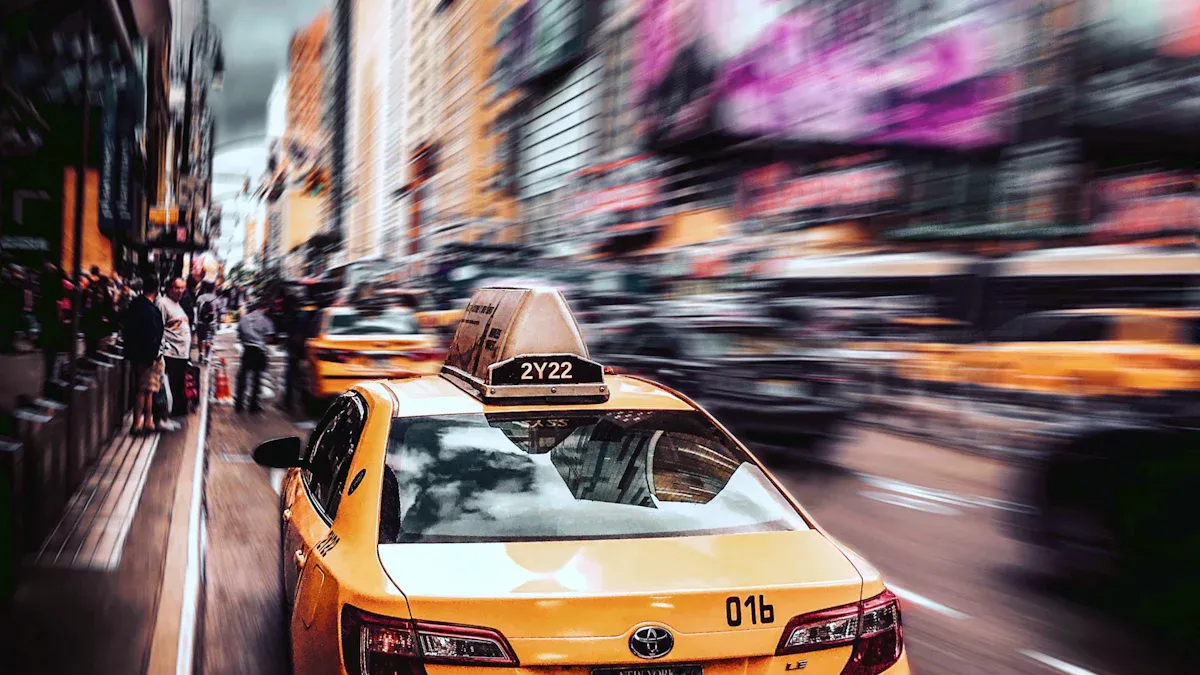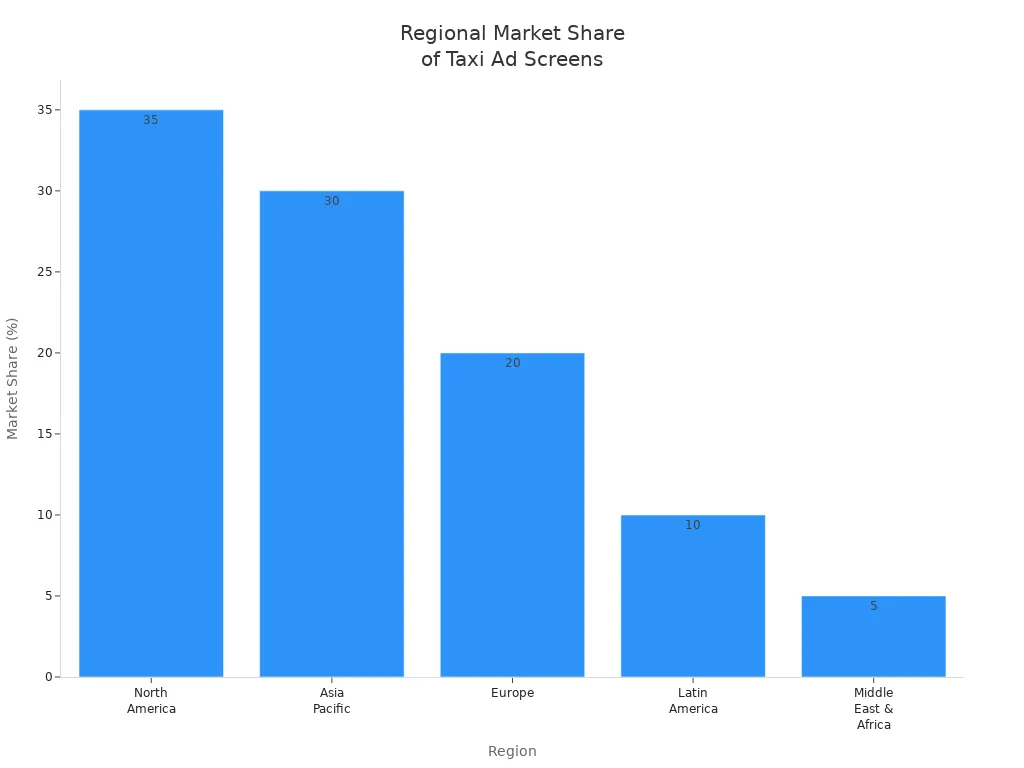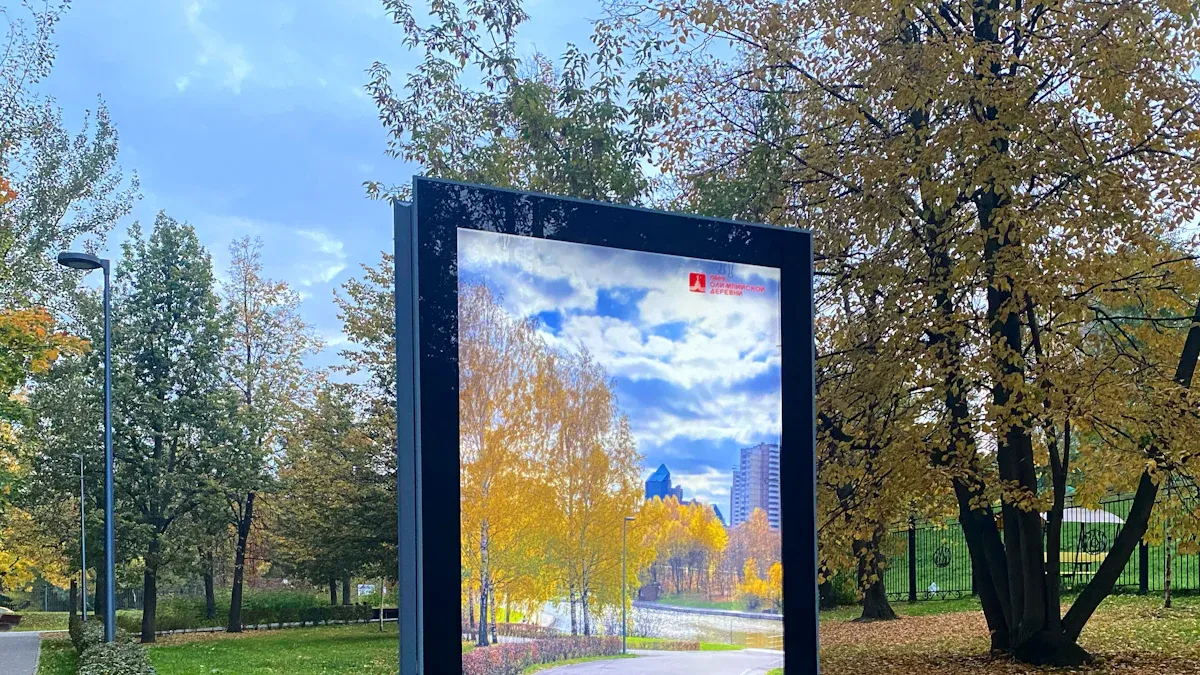
Location-based taxi ad screens offer strong investment value due to the rapidly growing market and unique advantages for advertisers.
Advertisers can reach a large urban audience since the screens are mounted on moving taxis, ensuring high visibility. These taxi ads feature dynamic content and location-based targeting, all at a lower cost than traditional billboards. The global market is valued at $1.2 billion in 2024, with experts predicting continued rapid growth over the next decade.
Always illuminated with bright lights
Passengers inside taxis can view and interact with the ads
Key Takeaways
Location-based taxi ad screens are easy to see and save money. They show changing ads on taxis that move around cities. This helps the ads reach lots of city people well.
These screens use GPS and data to pick ads for each place and time. This helps advertisers talk to the right people and get better ad results.
The taxi ad screen market is growing quickly all over the world. It is growing fastest in big cities and in Asia Pacific. This happens because more people live in cities and new digital tech is used.
Investors and operators can make more money by using screens that save energy. They can also update ads right away and work with local businesses.
There are problems like high hardware costs, privacy rules, and riders who want new things. To do well, people must update often, make good partnerships, and use data smartly.
Investment Value Overview

Key Benefits
Location-based taxi ad screens are a good investment for advertisers and taxi operators. These digital screens help taxis make more money as they move around busy cities. Taxi operators earn from selling ads. Advertisers can show their ads to many different people.
Taxi roof LED ads save money because there is no need to print anything or build big signs.
Advertisers can change ads fast using 4G or 5G networks. They can pick the best places and times for their ads.
GPS and data analytics help choose where and when to show ads. This makes sure the right people see them.
LED displays last a long time and use less energy. This means lower costs for repairs and power.
The screens are easy to see in cities, so more people notice the ads.
Taxi ad screens mix digital advertising’s targeting and changing content with outdoor ads’ wide reach. This makes them cheaper than old billboards, which helps small and medium businesses. Advertisers can count how many people see and interact with their ads. This helps them make better ads and get more value.
A table below shows the main benefits:
Benefit | Description |
|---|---|
Cost Savings | No printing costs; energy-efficient LEDs lower expenses |
Flexibility | Quick, remote content updates; flexible campaign durations |
Targeting | GPS and data analytics enable precise audience targeting |
High Visibility | Screens travel through multiple neighborhoods daily |
Measurable Results | Real-time data on impressions and engagement |
Case studies show brands using taxi ad screens get more store visitors, better brand awareness, and more online activity. For example, a coffee shop got more customers by showing ads on taxis near its shop. A tech company saw more social media posts after using interactive taxi ads.
Main Risks
Even though taxi ad screens are a good investment, there are some risks.
Hardware costs can go up if tariffs increase, especially in the U.S.
Problems in the supply chain can make parts harder to get and more expensive.
Technology changes fast, so upgrades are needed to keep up.
Different places use taxi ad screens in different ways, so plans must change for each area.
Working with display vendors, telecom companies, and content makers can be hard.
What passengers want changes, so ads and technology must change too.
New rules or trade policies can change how much things cost or how they are bought.
It can be hard to keep taxis running well and making money in a busy market.
Advertisers and taxi operators can lower these risks by using energy-saving tech, doing regular checkups, and working with good suppliers. They can also make more money by offering data services or getting help from the government. Doing research and staying flexible helps them grow and protect their investment.
Market Trends
Growth Rates
The in-taxi digital signage market has been growing each year. In 2021, it was worth about USD 648.90 million. By 2023, it grew to USD 2.47 billion. Experts think the advertising part will double by 2032. It may go from USD 1.25 billion in 2023 to USD 2.5 billion in 2032. This growth happens because more people live in cities now. Ride-sharing is also more popular. Technology is better too, with high-definition screens and data analytics.
The COVID-19 pandemic slowed things down for a while. Lockdowns and fewer taxi rides made demand drop. But the market got better when cities opened up again. Companies started using new technology. Programmatic advertising and real-time targeting help advertisers reach the right people. Tech companies and car makers are working together. For example, Yahoo and Xperi Inc. worked with BMW in 2023. This shows digital signage is now in more vehicles.
A table below shows the main reasons for growth:
Growth Factor | Details |
|---|---|
Urban Expansion | More people in cities increase demand for smart taxi ads |
Tech Advancements | HD displays, IoT, and touchscreens enable dynamic content |
Programmatic Ads | Targeted ads based on location, time, and demographics |
Software Growth | Real-time updates and analytics improve ad strategies |
Regional Market Shares | North America and Europe lead; Asia-Pacific grows fastest |
Regional Insights
Different regions use taxi ad screens in different ways. North America has the biggest share of the market. In 2023, it was worth USD 0.95 billion. This region uses new technology early and has strong digital systems. Europe is next, but its growth is not as fast.
Asia Pacific is growing the fastest. It has 30% of the market share now. It may make up over 35% of all revenue growth soon. More people are moving to cities there. Many people use smartphones and ride apps. Smart city projects and better digital systems help too.

The main reasons for these differences are:
Local culture affects what ads work best.
Better display technology makes ads look nicer.
Regular checkups keep screens working well.
Asia Pacific’s growth rate is between 12.5% and 16.5% CAGR. This is faster than other regions. North America is still the biggest market. But Asia Pacific is growing quickly and may change global trends.
Technology Trends

Location-Based Targeting
Taxi ad screens use GPS to show ads for each place. Advertisers pick which ads show in certain areas or near busy spots. This helps brands reach people based on where they are and what they do. For example, a restaurant can show breakfast ads in the morning near offices. GPS lets advertisers change ads from far away using 4G, WiFi, or GPS tools. These changes keep ads new and interesting. Location-based targeting makes more people see and react to ads. Brands get more customers than with old billboards. Taxi operators and advertisers can see which ads work best in each area. This information helps them make better ads and reach more people next time.
Location-based targeting helps taxi ad screens reach the right people at the best time.
Real-Time Content
Today’s taxi ad screens show ads that change right away. This technology has many new features:
Interactive screens let people touch and use the ads, so they remember them.
Real-time updates let ads change for news, weather, or traffic.
IoT technology helps show ads for certain times or local news.
Two network types (4G/5G and Wi-Fi) let people update ads from the cloud.
GPS geo-fencing shows ads when taxis go into special areas.
Cloud CMS helps manage ads, upload new ones, and set times or places for them.
The system collects data, like when the screen works and where ads play, to help make ads better.
Brightness control uses sensors to make screens easy to see and save power.
Local storage keeps ads playing if the network stops working.
Power management keeps the taxi’s battery safe and the screens working well.
These new tools help advertisers show the right ad at the right time. Real-time content keeps ads fun and interesting. This helps brands and taxi operators get better results.
Investment Analysis
Cost Breakdown
Taxi ad screens need money at the start for hardware and setup. Each taxi LED display screen costs between $800 and $2,000. The price depends on how big it is and what it can do. Operators also pay $200 to $500 to put the screen on each taxi. After that, they pay for power, data, and fixing the screens. These costs are still less than what billboards or signs cost.
Advertising prices for taxi screens change by city and type. The table below shows normal monthly prices:
Ad Format | Rate Range (per taxi per month) |
|---|---|
Taxi Top (Static) | $250 – $500 |
Taxi Top (Digital) | $350 – $600 |
Seat Back Screens | $5,000 – $20,000 |
In some cities, like Nashville, a taxi ad costs about $2,642.55 each month. Across the country, taxi ads cost $200 to $1,950 every four weeks. The price depends on when, how long, and how many people want ads. Taxi ads usually cost less than fancy digital ads, especially in smaller cities.
Taxi ad screens give good value in busy city areas. They help advertisers reach people that other ads might not.
Revenue Potential
Taxi ad screens make money in different ways. Advertisers pay to show their ads on top of taxis or inside them. How many ads show, how long trips last, and where taxis go all matter for earnings. Taxis in busy places or business areas can charge more because more people see the ads.
Big groups of taxis in cities like New York, London, and Shanghai make a lot of money. For example, 1,000 taxis with digital screens can earn $350,000 to $600,000 each month if each taxi makes $350 to $600. Seat back screens can make even more money—up to $20,000 per taxi each month in top cities.
How long taxis drive also matters. Taxis that work more hours or go farther show ads to more people. This means more people see the ads and advertisers get more value. Where taxis drive is important too. Taxis near airports, tourist spots, or downtown can get more money from advertisers.
Operators can earn more by selling special ad packages, picking certain neighborhoods, or selling top ad times during big events.
ROI Factors
Many things change how much money taxi ad screens make:
Advertising effect: Good, fun ads bring more advertisers and money.
Market competition: More rivals can lower ad prices and profits.
Policy environment: Helpful rules from the government help the business grow.
Advertising quality and duration: Better ads and longer times mean more people see them.
Operating costs: Lower bills for power, data, and repairs mean more profit.
Income sources: Working with brands, getting help from the government, and extra services bring in more money.
Market research and data analysis: Knowing what people want helps operators make better choices and earn more.
Operators who buy good hardware and use less energy do better. They also do well if they work closely with advertisers. Looking at data helps them pick the best times and places for ads.
Smart operators watch costs and try to make more money to get the most out of taxi ad screens.
Drivers and Challenges
Urbanization
Cities have many things like stores, homes, jobs, and fun places. This means people need to travel for different reasons.
More people want taxis in busy city spots where lots happens.
Taxis are used most near places like malls, offices, and event halls. These places get busier at certain times or on weekends.
Taxis are quick and easy for people who need to get somewhere fast.
Taxi GPS shows where and when people ride the most. This helps companies pick the best places for ad screens.
Taxis work all day and night, so ads can be seen anytime.
As cities grow, more people use taxis. This gives advertisers more chances to show ads in busy areas.
Taxi ad screens do best in big cities with lots of people and different places. Advertisers can use travel data to show ads to the right people at the right time.
Digital Ad Growth
Digital ads are growing very fast. In 2021, they made about $455 billion. Experts think this will go up by almost 11% each year until 2028. This makes more companies try new digital ads, like taxi ad screens. The in-taxi digital signage market could double from $1.2 billion in 2024 to $2.5 billion by 2033. More people use taxis and ride apps now. New tech makes ads smarter and more personal. Taxi ad screens let brands talk to riders while they travel. They can update ads right away and use cool features like AI or AR. These screens help advertisers connect with riders in a special way. This makes taxi ad screens a strong choice as digital ads get more popular.
Privacy & Regulation
There are many rules for taxi ad screens. Some places limit how bright or flashy screens can be to keep drivers safe.
In the U.S., distracted driving causes about 3,000 deaths each year. This means there are strict rules for screens inside cars.
Data privacy laws, like the California Consumer Privacy Act, make it harder to use passenger data for ads.
Many people worry about being tracked. About 67% of riders feel uneasy about location tracking in taxis.
It costs a lot to put screens in taxis, from $800 to $1,500 each. This makes it hard for small companies to join.
Some riders do not like digital ads in taxis. Around 42% say ads in small spaces feel annoying.
Rules and privacy worries mean companies must keep changing their systems and follow new laws.
Companies must make sure ads are safe and respect privacy. They need to follow local rules and care about what passengers think.
Technical Barriers
It is hard to build a big network of taxi ad screens. Companies often cannot buy ready-made hardware or software. They must make their own systems, which takes a lot of time and money. The screens must show ads that update right away, even when taxis move. This is tough and needs strong technology. Local governments can change rules fast and sometimes stop taxi ads without warning. Things like the COVID-19 pandemic can lower demand and make companies change their plans. These problems make it hard to grow taxi ad screen networks quickly.
Maximizing Returns
Data Analytics
Taxi ad screen operators use data analytics to get better results. They look at numbers like impressions, reach, and engagement. This helps them see how well ads do. Real-time feedback lets advertisers change ads fast. They can switch ads if something works better. Data analytics also shows how people act. Operators find out which ads get attention and which do not. This helps them make ads that fit each place and time.
Data analytics checks impressions, reach, and engagement for each ad.
Real-time feedback lets operators change ads and plans quickly.
Knowing how people act helps make ads that fit better.
Analytics shows what works and what does not, so money is spent wisely.
Using data with location and time makes ads more useful and powerful.
This way, brands get noticed more and ads work better.
Content Optimization
Operators use different ways to make taxi ad screen content better:
They keep messages short and strong, using catchy words that are easy to read.
They use moving words, bright colors, and brand colors to catch eyes.
They change ads for the time of day, who is watching, or special events to keep things new.
They plan ads for when people travel, like family ads on weekends or work ads during busy times.
They look at data about views and clicks to change when and how often ads show.
They make sure all ads are clear, follow rules, and are safe, working with taxi companies for easy updates.
These steps help more people see the ads and keep them interesting.
Partnerships
Working with others helps taxi ad screens make more money. Digital signage in taxis shows real-time, location-based ads to riders. When operators team up with local places like restaurants, hotels, or clinics, they get new ways to earn and grow their ad network. These partnerships fill slow times and help build trust in the community, making people like the brand more.
Local business partners bring new ads and make them fit better.
Deals with big companies give steady money from rides for workers or events.
Partners can add data and fun features to get riders more interested.
Working together lets operators show ads to the right people at the right time, making ads work better and earn more.
By making strong partnerships, operators make their taxi ad screen networks more valuable.
Future Outlook
Consumer Trends
People want more from digital ads in taxis now. They like ads that match where they are and what they like. Companies use GPS to show ads in certain places or on certain routes. Videos and moving pictures keep riders interested. Many taxi screens can change ads right away using 4G or 5G. This helps brands switch ads fast.
Touchscreens and phones let people use the ads.
Augmented reality (AR) makes ads fun and easy to remember.
AI and machine learning pick the best ads for each ride using traffic and rider info.
Data analytics check how well ads do and help make better ads later.
Brands use streaming video, games, and special offers to tell stories and connect with riders.
Companies work with car makers to put ad screens in new cars, so more people see them.
Energy-saving screens help the planet, and many people care about this.
These trends mean taxi ad screens will be more personal and fun. Riders will see ads that fit them, making each ride special.
Smart City Integration
Smart cities use tech to make life better for people. Taxi ad screens are now a big part of this. They work with smart city tools like IoT, AI, big data, and 5G. This lets taxis share live info and show ads just for you.
Taxi screens collect info to help cities fix traffic and plan roads.
Special LED screens look nice in cities and use less power.
Many screens and smart tools let ads be creative and helpful.
As smart cities grow, more taxis will get these new ad screens.
These screens help cities work better and give brands new ways to talk to people.
Taxi ad screens will be important in smart cities. They will help city leaders, help brands reach people, and make riding in taxis more fun.
Location-based taxi ad screens are a good way to invest. They can grow fast and give clear results. Investors have lots of chances to make money. But they need to watch out for new rules and tech changes. To do well, they should:
Try AI content tools to show better ads to people.
Work with tech companies to get real-time data.
Think about the planet and get ready for 5G.
Move into new markets and use data to make smart choices.
Keeping up with market changes and making updates often helps investors stay ahead and earn more.
FAQ
What is a location-based taxi ad screen?
A location-based taxi ad screen is a digital display on a taxi. It shows ads that change as the taxi moves around. Advertisers use GPS to pick where and who sees the ads.
How much does it cost to advertise on taxi ad screens?
It costs between $200 and $600 each month for one taxi. The price changes by city, screen type, and how long the ad runs. Seat back screens in big cities can cost even more.
Are taxi ad screens effective for small businesses?
Yes, they work well for small businesses. These ads help local shops reach people nearby. Taxis drive through many areas, so more people see the ads. Many small brands say they get more customers after using taxi ads.
Tip: Local shops should use short and simple messages for better results.
What are the main challenges with taxi ad screens?
Operators pay for hardware and must keep up with new tech. Local rules and privacy worries can make things harder. What riders like also matters for ad success. Updating ads often and working with good partners helps fix these problems.
See Also
Budget-Friendly Portable CarPlay Solutions For BMW F10 Drivers
Best CarPlay Adapter Choices For VW Golf In 2025
Cost-Effective Portable CarPlay Devices Suitable For All Drivers
